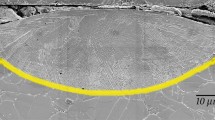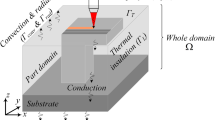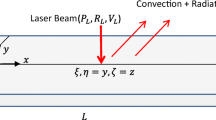Abstract
Nowadays, additive manufacturing via topology optimization creates new opportunities for weight reductions in aerospace industry where high fly-to-buy ratio is desired. Selective laser sintering of advanced engineering materials like nickel super alloys are also expanding to reduce the cost and time of the manufacturing in aerospace industry. Elevated temperature and temperature gradients are critical factors in selective laser sintering of metals and they significantly affect the quality and integrity factors of produced parts such as microstructures, porosity, residual stresses, and distortions. Therefore, the aerospace industry needs advanced simulation tools to predict the temperatures, temperature gradients, and molten pool geometries to better understand the physics of the selective laser melting process as well as for the process optimizations. This article introduces an adjustable finite element-based multi-physics and multi-software platform thermal model, for laser additive manufacturing in powder bed systems to predict the transient temperature and the molten pool geometry. The developed model is able to simulate 3D transient temperature and molten pool shape in the laser additive manufacturing process by including the features of melting and solidification, porous media, and temperature-dependent thermal material properties for different materials. A set of experiments of Inconel 625 is carried out in order to measure the size of the molten pool and to validate the developed thermal model. An experimental study on temperature distribution carried out with titanium and an experimental study on molten pool sizes carried out with Inconel 625 in the literature are also compared with the developed thermal model. The estimation errors of the developed model are in the range of 11–18%.
Similar content being viewed by others
References
Levy GN, Ralf S, Kruth JP (2003) Rapid Manufacturing And Rapid Tooling With Layer Manufacturing (Lm) Technologies, State Of The Art And Future Perspectıves. CIRP Ann Manuf Technol 52(2):589–609. https://doi.org/10.1016/S0007-8506(07)60206-6
Bikas H, Stavropoulos P, Chryssolouris G (2016) Additive manufacturing methods and modeling approaches: a critical review. Int J Adv Manuf Technol 83:389–405. https://doi.org/10.1007/s00170-015-7576-2
Chen L, He Y, Yang Y, Niu S, Ren H (2017) The research status and development trend of additive manufacturing technology. Int J Adv Manuf Technol 89:3651–3660. https://doi.org/10.1007/s00170-016-9335-4
Jaeger JC (1942) Moving sources of heat and the temperature at sliding contacts. Proc R Soc 76:203–224
Huang Y, Khamesee MB, Toyserkani E (2016) A comprehensive analytical model for laser powder-fed additive manufacturing. Addit Manuf 12(A):90–99. https://doi.org/10.1016/j.addma.2016.07.001
Matsumoto M, Shiomi M, Osakada K, Abe F (2002) Finite Element Analysis of Single Layer Forming on Metallic Powder Bed in Rapid Prototyping by Selective Laser Processing. Int J Mach Tools Manuf 42(1):61–67. https://doi.org/10.1016/S0890-6955(01)00093-1
Tolochko NK, Arshinov MK, Gusarov AV, Titov VI, Laoui T, Froyen L (2003) Mechanism of Selective Laser Sintering and Heat Transfer in Ti Powder. Rapid Prototyp J 9(5):314–326. https://doi.org/10.1108/13552540310502211
Li C, Guo YB, Zhao JB (2017) Interfacial phenomena and characteristics between the deposited material and substrate in selective laser melting Inconel 625. J Mater Process Technol 243:269–281. https://doi.org/10.1016/j.jmatprotec.2016.12.033
Farshidianfar MH, Khajepour A, Gerlich AP (2016) Real-time control of microstructure in laser additive manufacturing. Int J Adv Manuf Technol 82:1173–1186. https://doi.org/10.1007/s00170-015-7423-5
Kolossov S, Boillat E, Glardon R, Fischer P, Locher M (2004) 3D FE simulation for temperature evolution in the selective laser sintering process. Int J Mach Tools Manuf 44(2–3):117–123. https://doi.org/10.1016/j.ijmachtools.2003.10.019
Nisar A, Schimidt MJJ, Sheikh MA, Li L (2003) Three-dimensional transient finite element analysis of the laser enamelling process and moving heat source and phase change considerations. Proc Inst Mech Eng B J Eng Manuf 217:753–764. https://doi.org/10.1243/09544050360673143
Roberts IA, Wang CJ, Esterlein R, Stanford M, Mynors DJ (2009) A three-dimensional finite element analysis of the temperature field during laser melting of metal powders in additive layer manufacturing. Int J Mach Tool Manu 49:916–923. https://doi.org/10.1016/j.ijmachtools.2009.07.004
Ganci M, Zhu W, Buffa G, Fratini L, Bo S, Yan C (2017) A macroscale FEM-based approach for selective laser sintering of thermoplastics. Int J Adv Manuf Technol 91:3169–3180. https://doi.org/10.1007/s00170-017-9998-5
Somashekara MA, Naveenkumar M, Kumar A, Viswanath C, Simhambhatla S (2017) Investigations into effect of weld-deposition pattern on residual stress evolution for metallic additive manufacturing. Int J Adv Manuf Technol 90:2009–2025. https://doi.org/10.1007/s00170-016-9510-7
Kundakcioglu E, Lazoglu I, Rawal S (2016) Transient thermal modeling of laser-based additive manufacturing for 3D freeform structures. Int J Adv Manuf Technol 85(1):493–501. https://doi.org/10.1007/s00170-015-7932-2
Wang Z, Denlinger E, Michaleris P, Stoica AD, Ma D, Beese AM (2017) Residual stress mapping in Inconel 625 fabricated through additive manufacturing: Method for neutron diffraction measurements to validate thermomechanical model predictions. Mater Des 113:169–177. https://doi.org/10.1016/j.matdes.2016.10.003
Sih SS, Barlow JW (2004) The prediction of the emissivity and thermal conductivity of powder beds. Part Sci Technol 22(3):291–304. https://doi.org/10.1080/02726350490501682a
Mills KC (2002) Recommended Values of Thermophysical Properties for Selected Commercial. Woodhead Publishing, Cambridge
Acknowledgements
The authors would like to thank the Undersecretariat for Defence Industries (SSM) of Turkey and Tusaş Engine Industries Inc. for supporting the project.
Author information
Authors and Affiliations
Corresponding author
Rights and permissions
About this article
Cite this article
Kundakcıoğlu, E., Lazoglu, I., Poyraz, Ö. et al. Thermal and molten pool model in selective laser melting process of Inconel 625. Int J Adv Manuf Technol 95, 3977–3984 (2018). https://doi.org/10.1007/s00170-017-1489-1
Received:
Accepted:
Published:
Issue Date:
DOI: https://doi.org/10.1007/s00170-017-1489-1




